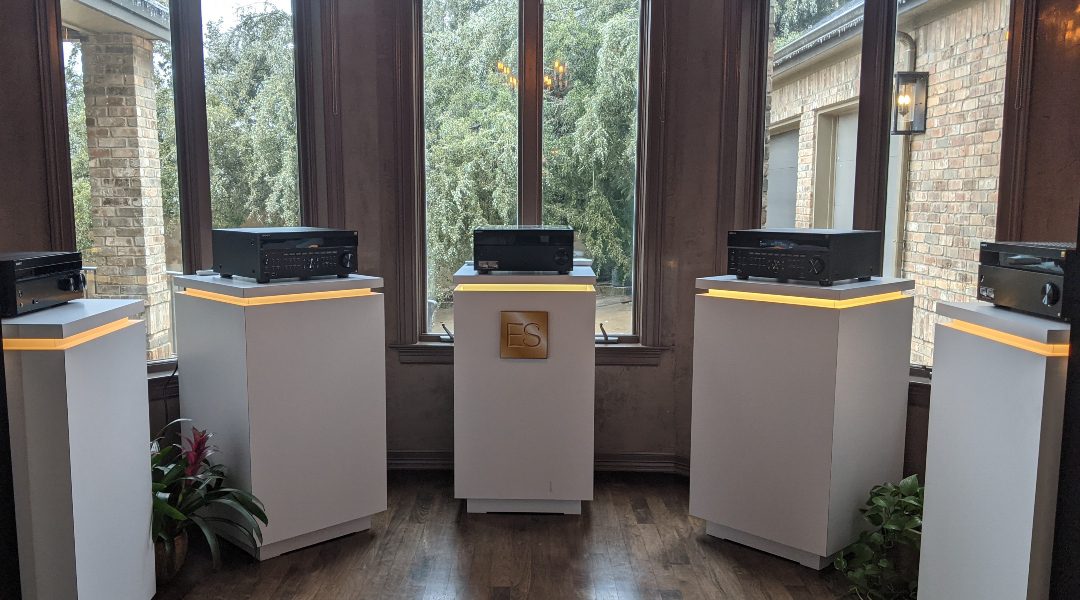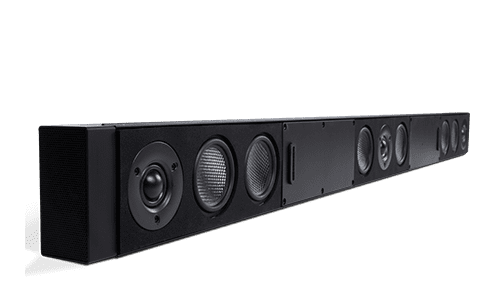I Previewed the New 8K Sony ES Receiver Lineup (and Was Blown Away)
The latest models of Sony’s professional grade receiver line offer range, versatility, and most importantly to installers, simplicity.

In the icy, frozen landscape that was Austin this week, myself and a handful of others were gathered to see Sony’s recently announced 8K AV receiver lineup for its Elevated Standard (ES) line. It was a journey, to say the least, both trying to get to the location through the downed trees and power lines and experiencing all that this new lineup has to offer, not just in terms of technical punch, but also with regards to the custom installation (CI) industry.
This latest entry in the ES Series features four receivers built exclusively for custom installations, as well as one consumer-grade model. Each model has varying capabilities between them, but the easiest way to distinguish them from the start is by the channel breakdown. The professional models are as follows:
- STR-AZ7000ES: 13.2 CH
- STR-AZ5000ES: 11.2 CH
- STR-AZ3000ES: 9.2CH
- STR-AZ1000ES: 7.2 CH
The consumer model STR-AN1000 supports 7.2 channel audio.
More than being a powerhouse of an AV receiver for all the audiophiles out there, Sony was clear: The new ES lineup was built for integration. Nearly every aspect of these devices have been retooled from previous models based on extensive feedback from the dealer level, with the result being a receiver that can easily incorporate itself into just about every home system while also providing one of the most immersive and clean AV experiences Sony has put out to date.
The New Sony ES Receiver is Designed to Sit at the Heart of AV Installations
Since its original introduction into the American market, the first Sony products were designed for audiophiles through and through. It was through the combined feedback and request from artists and musicians that the first Sony ES receiver was even created in the first place. Back then, the focus was on reliability and ease of use as the bedrock for all ES products, and that ethos stuck as Sony became more involved with the custom install space around the mid-80s.

Cast Your Vote for the 2023 CE Pro Quest for Quality Awards!
CE Pro urges integrators to recognize their suppliers that go above and beyond to deliver premium support and service. Cast your vote today to recognize the services (not the products) from your favorite manufacturers and distributors.
Since then, the intended buyer has shifted. It’s still made with audiophiles in mind, but Sony has stated that the core features and a significant chunk of what it has been working on with the new ES receiver lineup is focused exclusively on not just how this fits into a home theater, but how it fits into the ever evolving home ecosystem of control and automation.

Certain features vary between the different models but many of the core capabilities include a newly designed frame buffer board chassis and feet to increase stability and reduce vibration, 4K and 8K upscaling alongside HDR10, HLG, Dolby Vision and IMAX Enhanced, VRR and ALLM in HDMI 2.1, an updated wireless module to work with most wireless networks, new auto-calibration capabilities, center speaker enhancements, and 3D spatial audio mapping.
Installers are now also able to access most features of the ES receiver directly from the front without needing to interface with the GUI, though that still exists as an option if needed, Sony stated. There’s also settings save function that allows installers to store all configurations for the receiver on a thumb-drive that be used as a back up in the event of an issue.
Spatial Audio Capabilities Come to the Home Theater
During the time spent with the new lineup, myself and others were treated to a custom-built home theater experience—courtesy of Sony, KEF and Control4—where the STR-AZ7000ES receiver was put on full display controlling all 13 channels of audio. It was also there we got to experience the more advanced aspects of the product.
Center speaker enhancements allowed for clean placement of the central channels during some pulse-pounding cinematic moments (the subwoofers even providing a haptic element in some cases). The 3D Audio Mapping, meanwhile provided some incredibly immersive audio effects as well, with the auto-calibration via Digital Cinema Auto Calibration IX having dialed in a very impactful experience when sitting at the center of the theater.

Then everything turned over to the 360 Reality Audio demonstration. Having mostly used this technology in its headphones up to this point, the ES receiver is the first time Sony has dipped into creating immersive audio environments in a physical space. While there are limitations (there’s a specific format songs need to be recorded in to work with the feature), you can still color me impressed on the implementation.
Having come from a wellness background, spatial audio is something that, while deeply rooted in creating immersive environments (something I believe every AV integrator wants to create), has mostly stayed within the commercial sphere. Now, having seen, and experienced, what Sony is doing here, I find myself very excited for the future of home audio, especially as more artists begin recording in this 360 Reality format.
Sony’s ES Receiver Works with Sonos, and Just About Everything Else
Circling back to the greater emphasis Sony put on the custom install channels, the ES receiver comes with many built-in integrations for major control and home technology systems. With custom drivers for RTI, Savant, the new Crestron Home platform, Control4 and Elan to make set-up and integration simpler than ever before, the ES series are also the first products from Sony to include Works With Sonos.
Noting that Sonos is one of the most popular multi-room AV solutions in the home today, Sony stated that this new addition to receivers allows wireless Sonos devices to connect directly to the receiver. When placed on the same network as the receiver, integrators can easily connect wireless Sonos speakers in a process that takes roughly 15-20 minutes, according to Sony.
By integrating with OvrC, integrators can also wirelessly set-up, monitor and repair any issues customers may end up having with the receiver without sending someone out in person. Control4 integrations, meanwhile, offer a secret installer dashboard that even comes with instructions for first-time installers on the setup of the device within the system.
We also got to taste the versatility of the ES series from fulfilling luxury full home setups to an audiophile with some smart devices also present. In the lower section of the home, Savant showed how the receiver could work within the company’s sophisticated whole-house control system, while also incorporating cleanly in with many of its Cync products thanks to Alexa.
These partnerships, Sony says, are what it wants to emphasize as being a core strength of the new ES receiver line, and I can see it. In the age of post-Matter, interoperability is the feature everyone expects in the smart home, and installers expect that interoperability to come headache free.
Final Thoughts On the Presentation
Excitement is a good word to place on the whole experience. In concept, the end-user gets a massively enhanced audio experience, and the installer gets a massively improved configuration experience. Having seen it myself from an end-user perspective, I can attest to the former. However, CE Pro will also be exploring how it stacks up with the set-up in a forthcoming review of the STR-AZ5000ES, so stay tuned for that.
From my experience, the new ES lineup represents a series of surprisingly smart, powerful and versatile receivers that really live up to the name of ‘Elevated Standard.’ Sony’s stated commitment to the custom installation industry also shouldn’t be understated.
The choice to focus on this particular element during the presentation speaks volumes for these products and where Sony sees the industry moving forward with the ever present demand for crisp, immersive audio in the home as well as the growing influence of smart systems both large and small. It also shows an immense amount of consideration for the professionals installing this equipment with respect to time and availability of resources as the industry continues to move through tough times.

